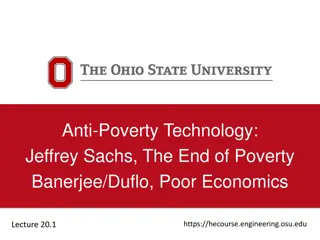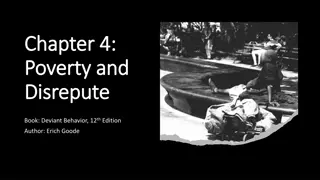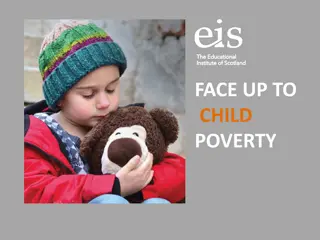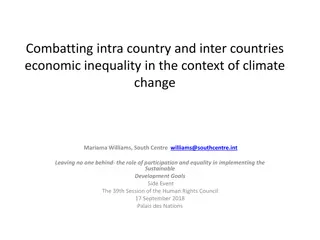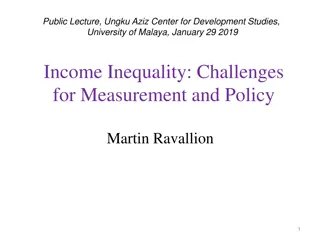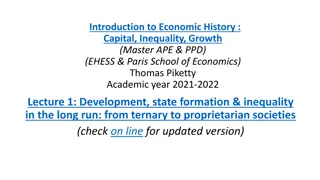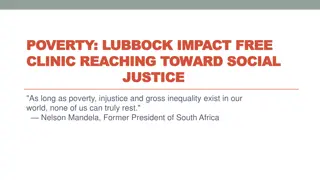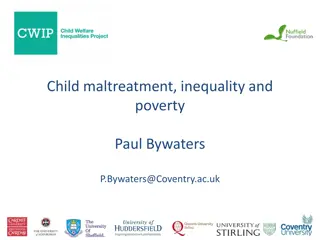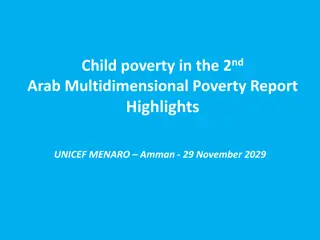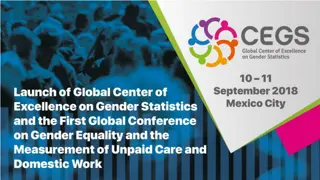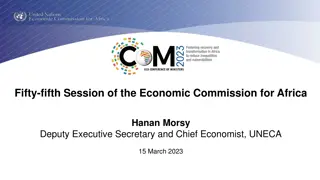Impact of Poverty and Inequality on the New Coronavirus
The presentation discusses how poverty and inequality influence the spread and severity of the new Coronavirus, emphasizing the vulnerabilities arising from socioeconomic inequalities. It highlights the increasing global poverty due to the pandemic and the importance of antipoverty policies in combating the virus. Furthermore, it outlines the WHO recommendations for protecting oneself from SARS-CoV-2 through various preventive measures.
Download Presentation

Please find below an Image/Link to download the presentation.
The content on the website is provided AS IS for your information and personal use only. It may not be sold, licensed, or shared on other websites without obtaining consent from the author.If you encounter any issues during the download, it is possible that the publisher has removed the file from their server.
You are allowed to download the files provided on this website for personal or commercial use, subject to the condition that they are used lawfully. All files are the property of their respective owners.
The content on the website is provided AS IS for your information and personal use only. It may not be sold, licensed, or shared on other websites without obtaining consent from the author.
E N D
Presentation Transcript
Poverty, Inequality and the New Coronavirus Martin Ravallion Georgetown University and the NBER
This presentation draws on: Caitlin Brown and Martin Ravallion, 2020, Inequality and the New Coronavirus: Socioeconomic Covariates of Behavioral Responses and Viral Outcomes Across US Counties. NBER Working Paper 27549. Caitlin Brown, Martin Ravallion and Dominique van de Walle, 2020, Can the World s Poor Protect Themselves from the New Coronavirus? NBER Working Paper 27200. Martin Ravallion, 2020, Pandemic Policies in Poor Places, Center for Global Development, Washington DC. 2
The pandemic is increasing global poverty Based on the World Bank s mid-2020 growth projections for developing countries, an extra 60 million people in 2020 are living below the Bank s $1.90 line due to the pandemic (Lakner et al., 2020). This calculation assumes that the COVID-contraction is distribution- neutral. Yet inequality could well rise within many countries given that poorer households are less able to maintain their earnings and consumption during the pandemic. Even a seemingly modest increase in inequality within developing countries could push the COVID impact on poverty up to 100 million people or more. 3
This presentation focuses instead on how poverty and inequality impact the spread and severity of the virus Two messages: 1. Socioeconomic inequalities underly vulnerability to the new Coronavirus. These are complex effects to disentangle. 2. There are important complementarities between antipoverty policies and health-care responses to the new Coronavirus. 4
Message 1: Socioeconomic inequalities underly vulnerability to the new Coronavirus 5
Message 1 The issues 6
WHO recommendations for protection from SARS-CoV-2 In the absence of a vaccine or antiviral treatments, much emphasis on the role of protective measures to reduce personal exposure. The World Health Organization (WHO) has provided detailed recommendations for people to protect themselves from the virus. These have been ratified by numerous national and provincial governments. The WHO recommendations built on prior literature and experience. 7
Prevailing non-pharmaceutical measures Learning: Keep up to date on the latest information from trusted sources, such as WHO. Isolating: Social distancing aims to lower the reproduction rate of the virus by reducing contacts per day. Masks as a complement. Washing: Regular hand washing with soap and water is strongly recommended. Treatment: If key symptoms exist (fever, difficulty breathing) then seek medical help. 8
Prevailing non-pharmaceutical measures Learning: Keep up to date on the latest information from trusted sources, such as WHO. Isolating: Social distancing aims to lower the reproduction rate of the virus by reducing contacts per day. Masks as a complement. Washing: Regular hand washing with soap and water is strongly recommended. Treatment: If key symptoms exist (fever, difficulty breathing) then seek medical help. 9
COVID-19 cases in the US after relaxing social distancing Reversal after opening up Policies, initial inequalities and behavioral responses underly these viral outcomes 10
Socioeconomic covariates of the spread of an infectious disease Social distancing is an outcome of constrained personal choices, though influenced by public policies. A large body of social and economic thought then becomes relevant to control of the spread of infections. And policy implications => Message 2. The socio-economic incidence of COVID-19 relate to longstanding concerns about the socioeconomic inequalities of health more broadly, as relevant to social policy and assessing social progress. Do such inequalities persist, or fade, over time as disease spreads? 11
Formal epidemiological models have typically assumed homogeneous populations The word poverty does not appear in the classic epidemiological texts by Anderson and May (1991), Gordis (2013) or Celentano and Szklo (2019). A richer modelling framework would allow for heterogeneity in the characteristics. Much of that heterogeneity reflects inequalities in various dimensions. oThe need to incorporate human behavior into epidemiological models is discussed further in Ferguson (2007) and Fenichel et al. (2011). oGreater awareness of socio-economic factors in the spread of infectious diseases with the emergence of social epidemiology (Honjo, 2004). oEllison (2020) shows how the standard Susceptible-Infectious-Recovered (SIR) model can incorporate socioeconomic factors. 12
Complexities in how poverty and inequality impact behavioral responses and viral outcomes Not much is obvious about how socioeconomic inequalities impact the spread of infectious diseases once one considers: oWealth-constrained behavioral responses through social distancing oAdjustment costs to a lower level of interaction oCorrelations among multiple covariates oNon-linearities w.r.t. incomes oLags and dynamics oReporting errors 13
What evidence is there to help inform our understanding of these issues? Micro data on COVID-19 cases and/or deaths that include socio- economic characteristics at the unit-record level are rare. Brown and Ravallion explore the empirical relationships across the 3,000 counties of the US. We merge: orecorded counts of cases and deaths at the county level, with osocio-economic characteristics average incomes, race, income inequality and poverty and odata on other covariates as suggested by the epidemiological literature. 14
Social distancing is a behavioral response to the threat posed by COVID-19 The benefit of social distancing is a lower expected loss from the virus: lower infection probability. Social distancing creates costs, by curtailing personal interactions that have value. The marginal cost of extra social distancing will differ. Poor people will may have a harder time complying. There will be adjustment costs, such that there is only partial compliance. The choice of how much to comply balances these benefits and costs. 15
Theoretical model of social distancing 1 Each person has a customary level of interactions with others, which entail an initial, pre-epidemic, level of social distancing ?. Each person re-optimizes in an epidemic by choosing a new level of social distancing, ? above ?. Adjustment cost, ?(.), is continuously increasing in ? ? with a rising adjustment cost as social distancing increases (???> 0). Starting from zero, a small amount of social distancing will not presumably come with much loss, as one gives up the least important interactions. However, as one gets closer to full lockdown, at ????, the loss will be large. So we assume that the net marginal benefit of social distancing is strictly decreasing in the amount of social distancing. 16
Theoretical model of social distancing 2 Customary interaction Infection probaibility Loss from infection Cost of social distancing: ?[?,?(?,?),?,?] = ?[? ?(?,?),?,?] + ?(?,?,?)?(?,?) current adjustment cost expected future loss We can also allow for benefits of social and economic interactions. Chosen compliance with social distancing recommendations or rules is the value ?(?,?) that equates margin benefit with marginal cost: ??(?,?,?) = ??[?,?(?,?),?,?] ? = ?(?,?) On implicitly differentiating with respect to ?: ??? ??? ??? ??? + protection effect (+) effect (?) ????? ??? ??? adjustment-cost ??(?,?) ?? = 17
Protection vs adjustment costs The protection effect: poverty curtails ability to avoid infection by social distancing; e.g., low-paying jobs cannot be done from home. The adjustment-cost effect: people cannot quickly and fully adjust to a lower level of socio-economic interactions when an epidemic hits. Rational but partial adjustment in response to the epidemic attenuates the level of social distancing in more affluent areas. The adjustment-cost effect can work in the opposite direction to the protection effect if poorer people are more socially isolated. 18
Age effects are also ambiguous Another potential ambiguity is in the (much discussed) effect of an elderly population, which enhances vulnerability to serious illness, once infected. However, this may well have the opposite effect on the probability of infection, via social distancing. Thus, the overall effect on fatalities is unclear. 19
Confounding correlations Socio-economic characteristics (poverty, race) are correlated with each other as well as with epidemiological and biomedical factors, such as population density and health pre-conditions. Similarly, average incomes are likely to be negatively correlated with the incidence of poverty, clouding inferences about whether the poverty effect is about average incomes or inequality, with distinct implications for policy. Brown and Ravallion consider multiple socio-economic variables as covariates for osocial distancing, othe spread of the infection and oseverity of illness, conditional on infection, as indicated by fatalities. 20
Infection rate when social distancing is personally optimal When social distancing is behaviorally optimal we can write the probability of infection as: ? = ?[?(?,?),?,?] ?(?,?) The aggregate infection rate: ?? ??= ??? ?,? Similarly, average social distancing: ??= ??[?(?,?)] + ?? + ?? 21
Nonlinearities and inequality Nonlinear income effects on personal choices about social distancing imply that the average amount of social distancing and the overall infection rate will depend on the distribution of income. On applying Jensen s inequality: o??[?(?,?)] < (>) ?(?(?),?) if ?(.) is increasing concave (convex) in ?. o??[?(?,?)] < (>) ?(?(?),?) if ?(.) is decreasing concave (convex) in ?. E.g., if the marginal increments to social distancing from extra income are higher for poorer people then higher inequality transferring income from the poor to the rich reduces mean social distancing. 22
Example: Inequality can reduce social distancing and increase the overall infection rate Infection rate (p) Social distancing (s) s(y) s[E(y)] E[p(y)] E[s(y)] p[E(y)] p(y) E(y) E(y) Income (y) Income (y) However, this is only one possible scenario consistent with our model 23
Other ways inequality can matter It may be harder to achieve the cooperation required to put in place collectively-beneficial pandemic response policies in societies that are more unequal in terms of both power and income. Similar arguments have been made about inequality and the provision of public goods (Bardhan, Bowles and Gintis 2000). Brown and Ravallion focus on the implications of income inequality for behavior with regard to social distancing. 24
In equilibrium: ?? ?? Dynamics also cloud the picture = ??? ?,? + ?? Lags imply non-homogeneities in the relationships: cases and deaths are nor directly proportional to population. ????? ???? ? ?,? = ?(????? 1 ???? ? ?,? ) + ??????+ ?? (1 > ? > 0,? + ?=1) Notice that the short-run elasticity of cases to population, ?, is less than unity, even though the equilibrium level of cases is directly proportional to population size (as long as ,? + ?=1). Given the likely dynamics, we should not expect a homogeneous relationship between current infections and population size. 25
Endogeneity of cases in modelling deaths Non-homogeneity due to the dynamics implies that case fatality rate varies with cases, which are endogenous. Identification strategy uses the epi curve, treated as excludable from the regression for deaths conditional on cases. Main threat to identification: hospital capacity, to be controlled for. 26
Message 1 Data and methods 27
Data Unacast s Social Distancing Scoreboard; grade comparing daily mobility with a pre-COVID-19 baseline using mobile phone GPS data. Google s COVID-19 Community Mobility Report, which tracks changes in visits and time spent at various activities relative to a baseline. COVID-19 cases and deaths from Centers for Disease Control and Protection (CDC). Most recent numbers at time of writing (June 18, 2020) New York Times data site for COVID-19. NYT records this according to the county in which they occurred, while CDC uses person s place of residence. Excess deaths from CDC; testing data at state level from the COVID-19 Tracking Project. Health indicators come from CDC. 28
Econometric models Social distancing: S?= ?0+ ?1??T?+ ?2??+ ?3??N?+ ?? (? = 1,..,?) oUnacast give an ordinal signal the index grades; we use an ordered logit. oGoogle data are continuous so OLS. Cases: C?= ???(?0+ ?1??T?+ ?2??+ ?3??N?+ ??) (? = 1,..,?) Deaths: D?= ???(?0+ ?1??+ ?2??+ ?3??C?+ ??) (? = 1,..,?) oBoth cases and deaths are overdispersed (high variance relative to mean) oNegative binomial specification using ML. 29
Message 1 Findings for the US 30
Social distancing slows the virus Evidence for US counties Across 3,000 US counties 1.0 12 Reported cases for COVID-19 (log scale) Reported cases for COVID-19 (log scale) 10 0.8 Proportion of counties Proportion of counties >100 cases per 100,000 >100 cases per 100,000 8 0.6 6 >200 >200 0.4 >300 >300 4 >400 >400 2 0.2 0 0.0 1 2 3 4 5 6 7 8 9 10 11 12 1 2 3 4 5 6 7 8 9 10 11 12 Performance in social distancing Performance in social distancing Performance in social distancing Performance in social distancing Data: CDC COVID-19 cases + Unacast s Social Distancing Scoreboard based on mobile phone GPS data. 31
Density Population Days since first case Median household income Share 65 and older Gini index Poverty rate Share of Black Americans State fixed effects No N (1) -1.09*** -1.02*** -1.10*** (0.05) (0.05) -0.04 -0.23** (0.10) (0.10) 0.02 0.06 (0.06) (0.06) 3.95*** (0.51) 1.57*** (0.21) -0.07 (0.62) 2.34*** (0.31) -0.24*** 0.03 (0.04) No 3054 3042 (2) (3) Regressions for improvements in social distancing (0.08) -0.80*** (0.16) 0.12* (0.06) 2.65*** (0.57) 0.53** (0.24) 0.46 (0.69) 2.25*** (0.34) Ordered logistic regressions using Unacast s Social Distancing Scoreboard based on mobile phone GPS data. Results are robust to using Google Mobility data instead. (0.06) Yes 3042 32
Regressions for COVID-19 cases Density Population Days since first case Median household income Share 65 and older Gini index Poverty rate Share of Black Americans Constant State fixed effects N (1) 0.19*** (0.02) 0.64*** (0.04) 0.95*** (0.04) -8.84*** (0.22) No 3142 (2) 0.19*** (0.02) 0.58*** (0.05) 0.88*** (0.04) 0.77*** (0.21) -1.37*** (0.09) 0.95*** (0.29) 0.76*** (0.13) -13.51*** -9.81*** (2.71) No 3128 (3) 0.03 (0.02) 0.82*** (0.04) 0.81*** (0.04) 0.45** (0.20) -1.22*** (0.09) 0.20 (0.28) 0.12 (0.13) 0.36*** (0.02) (4) 0.01 (0.03) 0.87*** (0.05) 0.73*** (0.04) 0.17 (0.21) -1.35*** (0.09) 0.14 (0.27) 0.19 (0.13) 0.40*** (0.02) -6.33** (2.70) Yes 3128 Negative binomial regressions (ML). Main results are robust to using NYT data instead. (2.61) No 3128 33
Income effects: Is it a higher average income or less poverty that reduces infections? Without controlling for poverty, a higher median income tends be associated with greater improvements in social distancing and lower infection rates. This is because counties with a higher median tend to have a lower poverty rate Controlling for median, higher poverty rate => higher infection and death rates. Controlling for poverty, higher median => higher infection and death rates. 34
Income effects: Both protection and adjustment effects are evident, but protection dominates The positive median-income effect on social distancing and infection rates is interpreted as due to adjustment costs, with richer families having more pre-COVID (econ+social) interaction The positive poverty effect is interpreted as reflecting protection (poor less protected) Higher income => higher pre-COVID interaction ????? ??? ??? adjustment- cost effect (-) ??? ??? ??? ??? + protection effect (+) ??(?,?) ?? = The overall negative effect of higher median, allowing the poverty rate to vary, suggests that the protection effect outweighs adjustment-cost effect. 35
Income inequality and the infection rate Once one controls for the median, the poverty rate is reflecting relative distribution. Counties with higher overall income inequality tend to have higher infection rates, which is in part due to the fact that higher inequality comes with higher poverty rates. Similarly, higher inequality between counties increases the overall (national) infection rate. The (independent) data on the social distancing response to the epidemic also support our argument that the protection effect dominates, with richer counties, and also more unequal counties, seeing stronger social distancing responses. 36
Race or poverty, or both? Brown and Ravallion also find a strong effect of race, separately to poverty; a higher population share of Black Americans tends to be associated with higher infection rates. Statistically, racial composition knocks out income poverty and inequality in predicting infection rates across counties. This is consistent with past observations that the essential workers, including in health care, are more likely to be Black Americans than for the population at large. Without controlling for the racial composition of counties one substantially over-estimates the impact of higher population density on infection rates. 37
Fading or magnifying as the virus spreads? As the infection spreads, the effects of poverty and inequality may well change, to the extent that different socioeconomic groups mix. Brown and Ravallion interact the socioeconomic characteristics with the number of days since the first case of COVID-19. B&R find little sign that the socioeconomic effects fade over time, the one exception being for the share of the population over 65. oThe elasticity w.r.t. this variable starts off at about twice its average level, but then fades over time, though remaining negative over entire range. The effect of a higher share of Black Americans starts off negative but soon becomes positive, and increases as days pass since 1st infection. The median and the poverty rate show a similar pattern. Inequality effects are magnified as the virus spreads. 38
Opposing effects of an elderly population As expected, death rates are higher for the elderly; the elasticity of deaths (controlling for the other variables, including cases) to the population share of the elderly is close to unity. However, this reverses when we turn to the infection rate. Younger people social distance less. The positive effect on deaths conditional on infections is roughly counter-balanced by the effect on the infection rate. 39
Message 2: Complementarities between antipoverty policy and health policy 40
Protection from the virus makes both behavioral and infrastructure demands So far, the focus of this presentation has been on social distancing as a behavioral response. However, when we take a global perspective the capacity of the home environment to facilitate protection becomes an issue. Containing the virus requires an adequate home environment for protection (HEP). Brown, Ravallion and van de Walle compare HEP across developing countries; one million sampled households from DHS + Facility Surveys. 41
The virus in the developing world There is an expectation that the virus will, or is, taking hold across much of the developing world. oYes, lower % of elderly, but twice as many people over 65 live in non-high- income countries. oPoor people depend heavily on current short-term earnings, incl. casual labor. Lower buffers. Concerns as to whether the home environments of the world s poor support protection (Andrew et al., Jones et al., Ravallion) Are the WHO recommendations applicable to poor places? 42
Message 2 Empirical implementation 43
Demographic and Health Surveys (DHS) Surveys in last 10 years; 1.05 million sampled households spanning 54 countries, with half the surveys completed since 2014. oSub-Saharan Africa (SSA): 31 surveys oCentral and South America: 6 surveys oAsia: 9 surveys oMiddle East, Eastern Europe, and North Africa: 8 surveys. The DHS focuses on health and demographic characteristics. Also household infrastructure, as relevant to assessing the quality of the HEP. DHS include a household wealth index based on a household s assets and living conditions. 44
HEP: To comply a household needs: 1. At least one of: internet, phone (land or mobile), TV, or radio. 2. No more than two people per room. Any more, it is difficult to implement the social distancing recommendations within h hold. 3. A toilet and doesn't have to share it with other households. Without this it will clearly be harder to implement social distancing. 4. A dwelling can be adequately closed, which we can interpret as the presence of walls and a ceiling. 5. Water piped into the dwelling or the yard, or some private source. 6. A place for handwashing with soap. 45
HEP index for developing world All countries Has internet, phone, tv, or radio Two members or less per room Has toilet and doesn't share Has wall and roof of any type Water source in dwelling or yard Has place to wash hands and soap Mean HEP Index Wealth quintile 3 1 2 4 5 Total 0.652 0.850 0.936 0.975 0.996 0.405 0.461 0.499 0.531 0.637 0.354 0.480 0.565 0.652 0.780 0.943 0.969 0.981 0.988 0.993 0.279 0.353 0.405 0.483 0.614 0.232 0.341 0.426 0.523 0.665 0.493 0.591 0.649 0.703 0.789 0.042 0.076 0.113 0.169 0.303 0.882 0.507 0.566 0.975 0.427 0.437 0.645 0.141 46
For sub-Saharan Africa Has internet, phone, tv, or radio Two members or less per room Has toilet and doesn't share Has wall and roof of any type Water source in dwelling or yard Has place to wash hands and soap Mean HEP Index Wealth quintile 3 0.872 0.515 0.440 0.980 0.171 0.148 0.533 0.015 1 2 4 5 Total 0.808 0.506 0.433 0.970 0.232 0.188 0.534 0.043 0.500 0.434 0.304 0.928 0.062 0.080 0.395 0.002 0.733 0.480 0.409 0.956 0.107 0.116 0.479 0.006 0.944 0.518 0.436 0.991 0.284 0.207 0.575 0.035 0.991 0.582 0.576 0.998 0.537 0.390 0.689 0.156 Virtually zero! 47
HEP index: Summary Learning: Good coverage overall. oYet half of the poorest quintile in SSA do not have any of the items. Isolating: A majority of those in the poorest two quintiles have: omore than two people per room, odo not have their own toilet, and othe vast majority across all wealth groups would have to leave their residence and yard for water. Hygiene: Less than half of households across the developing world have a place to wash hands with soap, and less than one in five in SSA. 48
HEP index: Summary cont. Overall, the HEP index is 14%: 4% in sub-Saharan Africa; 18% elsewhere. oAmong poorest few quintiles in SSA, the HEP index is virtually zero. SSA stands out for the high degree of inequality in HEP by wealth. The recommendations that have been implemented on a massive scale in the rich world are near fiction for the world s poor. 49
HEP index for all k by wealth quintile (n=40) All countries Mean HEP index k = 1 k = 2 k = 3 k = 4 k = 5 k = 6 Wealth quintile 1 2 3 4 5 Total 0.454 0.551 0.614 0.673 0.768 0.612 0.993 0.870 0.546 0.231 0.070 0.016 0.998 0.954 0.739 0.415 0.161 0.037 1.000 0.981 0.836 0.547 0.251 0.068 1.000 0.993 0.891 0.666 0.370 0.116 1.000 0.999 0.950 0.816 0.587 0.255 0.998 0.959 0.793 0.535 0.288 0.098 50


